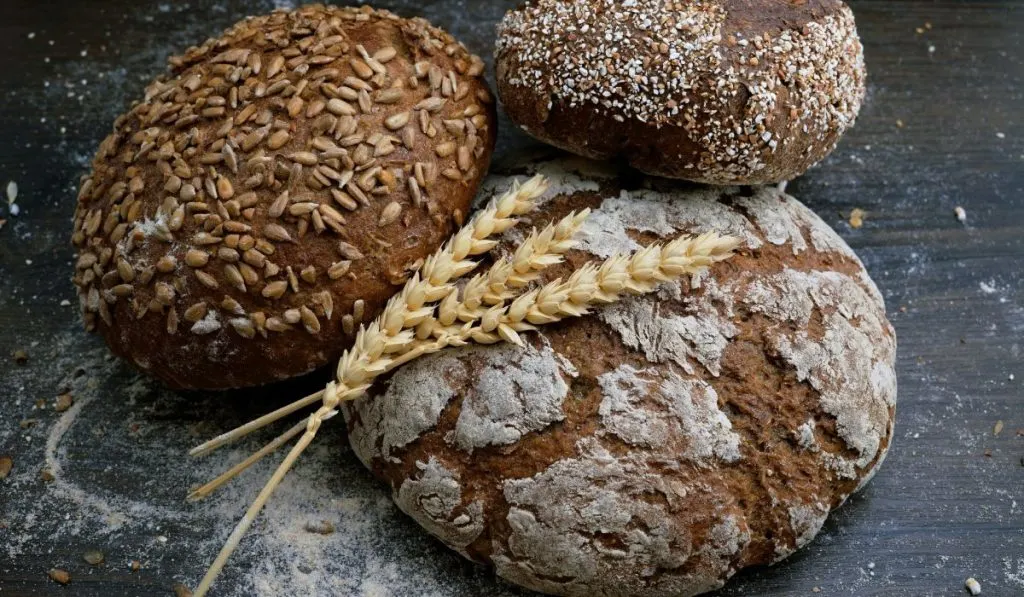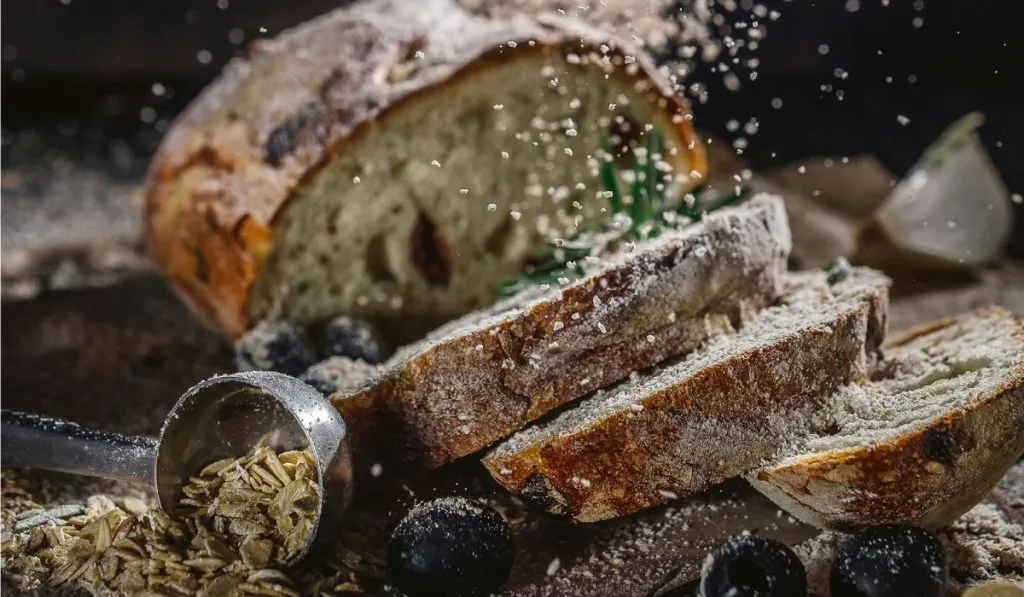
Enjoy the tangy, chewy goodness of sourdough bread without compromising your vegan lifestyle. Traditional recipes often include non-vegan ingredients like dairy or honey, posing challenges for plant-based eaters. Our comprehensive guide will teach you how to bake vegan sourdough bread at home, ensuring every bite is ethical and tasty.
Follow our step-by-step instructions and discover tips for perfecting your vegan sourdough, from creating a robust starter to achieving that perfect crust. Transform your baking skills and enjoy delicious, vegan-friendly sourdough bread with ease.
TL;DR
- Hydration Matters: Maintain a 100% hydration level for your starter.
- Fermentation Benefits: Long fermentation enhances digestion and lowers the glycemic index.
- Vegan Ingredients: Stick to flour, water, and salt, with creative vegan substitutions.
- Baking Techniques: Use preheated Dutch ovens or baking stones for the perfect crust.
- Flavor Variations: Experiment with plant-based ingredients like maple syrup and cinnamon.
The Vegan Sourdough Journey Begins
Baking sourdough bread is an age-old tradition, rich in flavor and history. But how do you make this classic favorite vegan without compromising on taste or texture? Welcome to your definitive guide to vegan sourdough bread!
In this article, you’ll find everything you need to know—from crafting the perfect starter to achieving that coveted crust, all while keeping it vegan. Let’s dive in!
Vegan Sourdough Bread Benefits: Why Choose Vegan Sourdough Bread?
Vegan sourdough bread offers a myriad of benefits, making it a top choice for health-conscious individuals and those committed to a plant-based lifestyle. Here’s why you should choose vegan sourdough bread:
- Healthier Digestion: Sourdough’s long fermentation process breaks down gluten and other proteins, making it easier to digest than conventional bread. The natural fermentation also promotes the growth of beneficial bacteria, supporting a healthy gut microbiome.
- Lower Glycemic Index: The fermentation process lowers the glycemic index of sourdough bread, meaning it has a less significant impact on blood sugar levels. This makes vegan sourdough a better option for those managing blood sugar levels or looking for a more balanced energy source.
- Nutrient-Rich: Sourdough fermentation enhances the bioavailability of nutrients, making it easier for your body to absorb essential vitamins and minerals like B vitamins, folate, and antioxidants. This nutrient boost supports overall health and wellbeing.
- No Animal Products: Vegan sourdough is free from animal products, aligning with ethical and environmental values. It supports sustainable food practices by avoiding dairy, honey, or eggs, making it suitable for vegans and those with dietary restrictions.
- Flavorful and Versatile: The tangy flavor of sourdough is unmatched, and it pairs well with both sweet and savory toppings. Its chewy texture and crusty exterior make it a delight to eat on its own or as a part of various dishes.
- Longer Shelf Life: The natural acidity of sourdough acts as a preservative, extending the bread’s shelf life and reducing waste. This makes vegan sourdough a practical choice for those looking to minimize food spoilage.
Choosing vegan sourdough bread means opting for a healthier, more nutritious, and ethical option. Enjoy the benefits of this delicious bread while supporting your health and the environment.
Vegan Sourdough Bread Ingredients
| Ingredient | Role in Bread | Benefits |
|---|---|---|
| Flour | Provides structure and gluten development | Rich in carbohydrates and proteins for energy and growth |
| Water | Hydrates the flour and activates the yeast | Essential for the dough consistency and fermentation |
| Salt | Enhances flavor and controls fermentation | Improves taste and extends shelf life |
| Vegan Sweeteners (Maple Syrup, Agave, Date syrup) | Adds sweetness and moisture | Natural sweeteners with additional minerals and antioxidants |
| Plant-based Milk | Enhances flavor and texture | Adds creaminess and richness without dairy |
| Vegan Oils | Enhances moisture and flavor | Vegan oils are rich in monounsaturated and polyunsaturated fats, which are heart-healthy and help reduce bad cholesterol levels. |
| Vegan Add-ins (Nuts, Seeds, Dried Fruits, Citrus Peels) | Adds flavor, texture, and nutritional benefits | Boosts nutrient content with fiber, vitamins, and healthy fats |
| Spices Add-ins (Cinnamon, Nutmeg, and Cardamom) | Enhances flavor and aromas | Boosting overall nutritional value of the bread. |
Vegan Sourdough Bread: Optional Add-Ins for Extra Delight

Enhance your vegan sourdough bread with a variety of delicious and nutritious add-ins. Incorporating vegan-friendly ingredients like nuts, seeds, and dried fruits not only elevates the flavor and texture of your bread but also provides substantial health benefits.
- Nuts such as almonds, walnuts, and pecans add a satisfying crunch and a rich, nutty flavor. They are packed with healthy fats, protein, and fiber, making your bread more filling and nutritious. Additionally, nuts are excellent sources of vitamins and minerals, including vitamin E, magnesium, and potassium, which support heart health and overall well-being.
- Seeds like chia, flax, and sunflower seeds bring a delightful crunch and a subtle earthy taste to your sourdough. These tiny powerhouses are rich in omega-3 fatty acids, which are essential for brain health and reducing inflammation. Seeds also provide a good dose of fiber, aiding digestion, and helping to maintain a healthy gut.
- Dried Fruits such as raisins, cranberries, and apricots infuse your sourdough with natural sweetness and chewy texture. These fruits are high in antioxidants, vitamins, and minerals, such as vitamin C and potassium. They can boost your immune system, improve skin health, and provide a quick energy source.
- Oils like olive or coconut oil can enrich the dough, adding moisture and a subtle flavor. These healthy fats are beneficial for heart health and add a luxurious texture to your bread.
- Citrus Peels such as lemon and orange peels can add a refreshing zest to your bread. They are rich in antioxidants and vitamin C, enhancing the bread’s flavor and nutritional profile.
- Spices like cinnamon, nutmeg, and cardamom add unique flavors and aromas to vegan sourdough bread, enhancing its taste and making each loaf more aromatic and delightful.
By adding these vegan-friendly ingredients, you not only enhance the taste and texture of your sourdough bread but also significantly boost its nutritional value. This makes your homemade vegan sourdough a wholesome and delicious choice for any meal. Enjoy the benefits of these optional add-ins and transform your bread into a delightful, nutrient-dense treat.
Optional Add-Ins for Vegan Sourdough Bread
| Add-In | Role in Bread | Benefits |
|---|---|---|
| Nuts (Almonds, Walnuts, Pecans) | Adds a rich, nutty flavor and satisfying crunch | Rich in healthy fats, protein, fiber, vitamins, and minerals, supporting heart health and overall well-being |
| Seeds (Chia, Flax, Sunflower) | Provides a subtle earthy taste and crunchy texture | High in omega-3 fatty acids, fiber, and essential nutrients, aiding digestion and brain health |
| Dried Fruits (Raisins, Cranberries, Apricots) | Infuses natural sweetness and chewy texture | Packed with antioxidants, vitamins, and minerals, boosting immune system and providing quick energy |
| Vegan Oils (Olive Oil, Coconut Oil, Avocado Oil) | Vegan oils in sourdough bread improve moisture, texture, flavor, and shelf life. | Incorporating vegan oils into sourdough bread enhances moisture, texture, flavor, nutritional value, and shelf life while providing healthy fats and essential vitamins. |
| Citrus peels (Lemon and Orange) | Citrus peels add a refreshing zest and enhance the flavor of your bread. | Rich in antioxidants and vitamin C, boosting the bread’s nutritional profile. |
| Spices (Cinnamon, Nutmeg, and Cardamom) | Enhancing taste of the to vegan sourdough bread and making each loaf more aromatic and delightful. | Spices provide health benefits such as anti-inflammatory properties, improved digestion, and additional antioxidants, boosting the overall nutritional value of the bread. |
Understanding Vegan Sourdough Bread
Before we jump into the recipe, it’s crucial to understand what makes sourdough bread vegan. Traditional sourdough bread only requires three primary ingredients: flour, water, and salt. However, some recipes sneak in non-vegan items like honey or dairy products. Our guide focuses on maintaining the purity of vegan ingredients while enhancing the bread’s natural flavors.
The Science Behind Sourdough
Sourdough bread is a marvel of natural fermentation, rising due to the action of wild yeast and lactic acid bacteria present in the starter. This unique process starts with the wild yeast, which ferments the carbohydrates in the flour, producing carbon dioxide and alcohol. The carbon dioxide gas gets trapped in the dough, creating the bubbles that give sourdough its airy texture.
Meanwhile, lactic acid bacteria play a crucial role by converting sugars into lactic acid, which imparts the distinctive tangy flavor that sourdough enthusiasts love. This acidification process not only contributes to the bread’s taste but also lowers the pH of the dough, inhibiting the growth of unwanted bacteria and molds, thereby extending the bread’s shelf life.
The fermentation process breaks down gluten and other proteins, making sourdough bread easier to digest than conventional bread. This makes it a great option for people with gluten sensitivities (though not for those with celiac disease). Additionally, the prolonged fermentation increases the availability of nutrients, such as B vitamins, folate, and antioxidants, enhancing the bread’s nutritional profile.
The science behind sourdough is a harmonious dance of wild yeast and lactic acid bacteria, resulting in a flavorful, nutritious, and easily digestible bread. This natural fermentation process is what sets sourdough apart, making it a beloved choice for health-conscious bakers and bread lovers alike.
Creating Your Vegan Sourdough Starter
The journey to perfect vegan sourdough begins with a robust starter.
Here’s how to create and maintain it:
Ingredients:
- Flour: Use unbleached all-purpose or whole wheat flour.
- Water: Non-chlorinated or distilled water is best.
- Container: A glass jar or bowl.
Method:
- Day 1: Mix equal parts flour and water (by weight) in your container. Cover loosely and let sit at room temperature.
- Day 2-7: Discard half of the starter and feed it with equal parts flour and water daily.
- Day 8: Your starter should be bubbly and ready to use.
Pro Tip: Feed your starter regularly to keep it active. A well-maintained starter is the key to great sourdough bread.
Perfecting the Dough

Once your starter is active, it’s time to make the dough. Here’s a foolproof recipe:
Ingredients:
- Active Sourdough Starter: 1 cup
- Flour: 3 ½ cups (you can mix all-purpose with whole wheat or specialty flours like buckwheat or oat)
- Water: 1 ½ cups
- Salt: 2 teaspoons
Optional Add-ins (quantities to taste, adjust as desired): Plant-based milk, maple syrup, Vegan Oils or vegan sweeteners for variations
- Plant-based Milk: ¼ cup
- Maple Syrup: 2 tablespoons
- Vegan Oils (e.g., Olive Oil): 2 tablespoons
- Citrus Peels (Lemon or Orange): 1 tablespoon, finely grated
- Spices (e.g., Cinnamon, Nutmeg): 1 teaspoon
- Seeds (e.g., Chia, Flax, Sunflower): 2 tablespoons
- Dried Fruits (e.g., Raisins, Cranberries, Apricots): ½ cup
- Vegan Sweeteners: 2 tablespoons (if substituting for maple syrup)
Method:
- Mixing: In a large bowl, combine the starter, water, and flour. Mix until a shaggy dough forms.
- Autolyse: Let the dough rest for 30 minutes. This step helps with gluten development.
- Add Salt: Mix in the salt and any optional ingredients.
- Kneading: Knead the dough using the stretch and fold method every 30 minutes for 2 hours.
- Bulk Fermentation: Cover and let the dough rise at room temperature for 4-6 hours or until doubled in size.
- Shaping: Gently shape the dough into a boule or batard.
- Proofing: Place the shaped dough in a floured proofing basket or bowl. Cover and let it proof in the fridge overnight.
Baking the Vegan Sourdough Bread
Mastering sourdough bread requires a few specific techniques to achieve the best results:
Baking Equipment:
- Dutch Oven or Baking Stone: Preheat these in your oven to ensure a crusty exterior.
- Lame or Sharp Knife: For scoring the dough.
Method:
- Preheat Oven: Preheat your oven to 450°F (230°C) with the Dutch oven or baking stone inside.
- Score the Dough: Just before baking, score the top of the dough with a lame or sharp knife.
- Bake: Transfer the dough to the preheated Dutch oven or baking stone. Cover (if using a Dutch oven) and bake for 20 minutes. Remove the lid and bake for an additional 20-25 minutes until golden brown.
- Cool: Let the bread cool completely on a wire rack before slicing.
Pro Tip: For a softer crust, place a pan of water at the bottom of the oven to create steam.
Tips and Tricks for the Perfect Vegan Sourdough
Hydration Management
- Sticky Dough: High hydration levels can make the dough sticky and tricky to handle. Use wet hands or sprinkle flour to manage it effectively.
- Consistency: Maintain a consistent feeding schedule for your starter to ensure it stays active and vibrant.
Flavor Variations
- Add-Ins: Experiment with plant-based ingredients like nuts, seeds, dried fruits, and spices to enhance flavor and texture.
- Sweet Sourdough: Add cinnamon, raisins, or vegan chocolate chips for a delightful sweet twist.
Handling and Shaping
- Stretch and Fold: This technique helps develop gluten without traditional kneading, ensuring a good structure.
- Proofing: Longer, cooler proofs develop more complex flavors. An overnight proof in the fridge works wonders for taste and texture.
Troubleshooting Common Issues
Flat Loaves:
- Inactive Starter: Ensure your starter is bubbly and active before using it.
- Underproofing: Give your dough enough time to rise. A slow, cool rise often yields the best results.
Dense Bread:
- Overmixing: Avoid overmixing the dough, which can deflate the air pockets and make the bread dense.
- Flour Choice: Whole grain flours can make bread denser. Mixing them with all-purpose flour can help balance the texture for a lighter loaf.
By following these tips and tricks, you can master the art of baking vegan sourdough bread, achieving perfect results every time. Enjoy the process and savor the delicious, plant-based goodness of your homemade bread.
Conclusion: Your Vegan Sourdough Mastery
Baking vegan sourdough bread is a rewarding journey that combines science, art, and a bit of patience. With the right techniques and some practice, you’ll soon be enjoying delicious, crusty loaves that are entirely plant-based.
Here’s my personal advice: start by creating a strong, active starter—this is the heart of your sourdough. Feed it consistently and watch it bubble with life.
When mixing your dough, don’t rush. Allow time for autolyse and fermentation; these steps are crucial for developing flavor and texture. Use the stretch and fold method to build gluten without traditional kneading, and don’t be afraid to experiment with add-ins like nuts, seeds, and dried fruits to make your bread unique.
Proof your dough in a cool place overnight for deeper flavors, and remember, patience is key. Baking with a preheated Dutch oven or baking stone will give your bread that perfect crust. Finally, let your bread cool completely before slicing to avoid a gummy texture.
Gather your ingredients, activate your starter, and dive into the delightful world of vegan sourdough baking. Enjoy the process, embrace the learning curve, and soon you’ll master the art of baking wholesome, delicious vegan sourdough bread. Happy baking!
FAQs
What is a vegan sourdough starter?
A vegan sourdough starter is made with just flour and water, avoiding any animal products. It relies on wild yeast and bacteria for fermentation.
How long does it take to make vegan sourdough bread?
From start to finish, including the starter preparation, it can take about a week to make vegan sourdough bread. The actual dough preparation and baking take about 24-48 hours.
Can I use gluten-free flour for vegan sourdough bread?
Yes, but the process is different, and you may need to use additional ingredients like xanthan gum to mimic the properties of gluten.
What are some common mistakes in making sourdough bread?
Common mistakes include underfeeding the starter, not giving the dough enough time to rise, and baking at incorrect temperatures.
How should I store vegan sourdough bread?
Store it in a paper bag at room temperature for up to three days or freeze it for longer storage. Avoid plastic bags as they can make the crust soggy.
Join Us and Transform >
Don’t Be an Amateur! Master the Art of Sourdough Bread!




Leave a comment